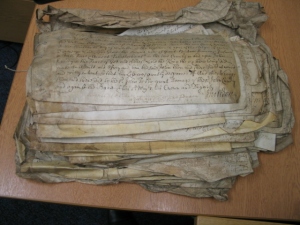It’s funny in life how one piece of research can suddenly spark off another and within the space of a week another major discovery about the Devon Quarter Sessions bundles has been made. Since the beginning of this cataloguing project, it’s been painfully apparent that a huge amount of the documentation relating to the Sessions bundles has been incredibly disordered, and arranging this material logically has taken a great deal of time and effort, and the assistance of a team of dedicated volunteers. Many of the boxes containing Sessions bundles are, before cataloguing, originally labelled thusly: “1742 Easter+Midsummer and loose.” The ‘and loose’ part of that label is the pertinent bit here. What it means in practice is that the box will usually contain several stacks of documentation more or less thrown together at random, often encompassing material spanning many different years and many different sessions. Witness statements for cases that were before the court several years ago survive alongside constables’ presentments for a completely different Session, for example….occasionally there are whole boxes of this material more or less thrown together at random.
What hasn’t been clear until now, however, is why this material is so disordered. In previous posts I’ve made various comments suggesting that at some point in this material’s custodial history the documents had clearly become disordered, but I’ve not really entertained much hope of discovering why during this year, suspecting that the reasons for the disorder might be lost in the mists of time, or might only re-emerge after considerably more research had been done.
Happily, however, a chance discovery while researching something entirely different has gone a long way to solving the mystery. In 1800, Parliament commissioned a Select Committee to make an enquiry into the state of the nation’s public records, (which itself created a report with the catchy title : “Reports from the Select Committee Appointed to Inquire into the State of the Public Records of the Kingdom, Etc”), and in an appendix to that report, the Clerks of the Peace of the various Counties of England and Wales gave brief answers to various questions posed about the records in their care. Devon’s Clerk of the Peace at the time was a chap called Richard Eales, junior, and he made some tantalising comments on pp266-267 of the Report regarding the manner in which the records had been kept up to 1800.
Previously to 1773 the Quarter Sessions material had been kept in the records room at the old castle in Exeter, but in 1773 the old castle was taken down, and the records that were held in the record room were ‘thrown together and I have from time to time since I became acquainted with the office (twenty four years) spent with the late clerk of the peace many months in arranging them in some order, and for one hundred and fifty years back the records are now pretty well arranged and deposited in large presses made for the purpose in the record room.”
It would seem then that this innocuous statement is the key to the mystery of the stacks of loose documents that survive with each of the Sessions rolls, and which are composed of such disorganised material. The material had been thrown together in complete confusion around 1773 and what we find in the boxes prior to cataloguing is the clerk’s best guess at restoring some order, done, it has to be said from the point of view of the archivist who inherited the situation, with varying degrees of success!
Eales was clearly a pragmatic sort and some of his other comments, particularly with regard to indexing the collection, are quite informative:
“I am of the opinion, that if the rolls were completely arranged and indexed, it would save great trouble to the clerk of the peace, as they could be sooner turned to and inspected, but I know of no other utility that could arise from it: the Trouble and Expenses attending from such an arrangement would be immense, and I could not undertake to do it, with an additional clerk, in less than twelve months.”
I have to admit to chuckling when I read the above. I wonder what he’d make of this twenty-first century cataloguing project, using electronic computers, cataloguing software, the Internet, IRIS machines for making faded ink as clear as day to the eye again, and all the modern research tools of our era? Food for thought, anyway!
What I like most about the above though is that it gives a satisfying sense of filling in some of the missing pieces about these records. Part of the point of this project is to help us to better understand the records being catalogued, and that includes the history of how the collection itself was kept by past generations. Now we have a very important piece of the puzzle, and can speak with more confidence about how the records came to be the way they are today, with all the challenges and charms they bring to present-day archivists and researchers.

